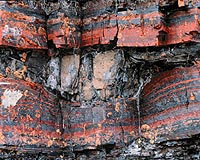| . |  |
. |
Paris (AFP) July 13, 2009 A runaway spurt of global warming 55 million years ago turned Earth into a hothouse but how this happened remains worryingly unclear, scientists said on Monday. Previous research into this period, called the Palaeocene-Eocene Thermal Maximum, or PETM, estimates the planet's surface temperature blasted upwards by between five and nine degrees Celsius (nine and 16.2 degrees Fahrenheit) in just a few thousand years. The Arctic Ocean warmed to 23 C (73 F), or about the temperature of a lukewarm bath. How PETM happened is unclear but climatologists are eager to find out, as this could shed light on aspects of global warming today. What seems clear is that a huge amount of heat-trapping "greenhouse" gases -- natural, as opposed to man-made -- were disgorged in a very short time. The theorised sources include volcanic activity and the sudden release of methane hydrates in the ocean. A trio of Earth scientists, led by Richard Zeebe of the University of Hawaii, try to account for the carbon that was spewed out during PETM. They believe that levels of atmospheric carbon dioxide (CO2) rose by 70 percent during PETM's main phase to reach 1,700 parts per million (ppm), attaining a concentration of between four and five times that of today. But all this CO2 can only account for between one and 3.5 C (1.8-6.3 F) of PETM's warming if the models for climate sensitivity are right, the team found. There must have been some other factor that stoked temperatures higher. Even though there are big differences between Earth's geology and ice cover then and now, the findings are relevant as they highlight the risk of hidden mechanisms that add dramatically to warming, says the paper. Some of these so-called "positive feedbacks" are already known. For instance, when a patch of Arctic sea ice melts, this exposes the uncovered sea to sunlight, depriving it of a bright, reflective layer. That causes the sea to warm, which leads to the loss of more ice, which in turn helps the sea to warm, and so on. But these "feedbacks" are poorly understood and some scientists believe there could be others still to be identified. "Our results imply a fundamental gap in our understanding about the amplitude of global warming associated with large and abrupt climate perturbations," warns Zeebe's team. "This gap needs to be filled to confidently predict future climate change." After the big warm-up, the planet eventually cooled around 100,000 years later, but not before there had been a mass extinction, paving the way to the biodiversity that is familiar to us today. Man-made global warming, driven mainly by the burning of oil, gas and coal, has amounted to around 0.8 C (1.12 F) over the past century. Last week in L'Aquila, Italy, the Group of Eight (G8) industrialised countries and other economies that together account for 80 percent of greenhouse-gas emissions pledged to try to limit overall warming to 2 C (3.6 F) over pre-industrial times. Share This Article With Planet Earth
Related Links Explore The Early Earth at TerraDaily.com
 Rock Bands Spin An Oxygen Record
Rock Bands Spin An Oxygen RecordMoffett Field CA (SPX) Jun 23, 2009 The first half of Earth's history was devoid of oxygen, but it was far from lifeless. There is ongoing debate over who the main biological players were in this pre-oxygen world, but researchers are digging up clues in some of the oldest sedimentary rocks on the planet. Most scientists believe the amount of atmospheric oxygen was insignificant up until about 2.4 billion years ago when the ... read more |
|
| The content herein, unless otherwise known to be public domain, are Copyright 1995-2009 - SpaceDaily. AFP and UPI Wire Stories are copyright Agence France-Presse and United Press International. ESA Portal Reports are copyright European Space Agency. All NASA sourced material is public domain. Additional copyrights may apply in whole or part to other bona fide parties. Advertising does not imply endorsement,agreement or approval of any opinions, statements or information provided by SpaceDaily on any Web page published or hosted by SpaceDaily. Privacy Statement |